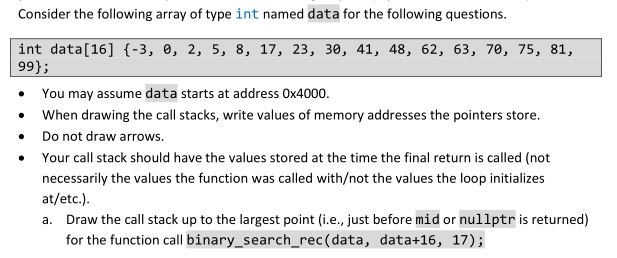Answered step by step
Verified Expert Solution
Question
1 Approved Answer
Please draw the call stack and answer the question a and b. I will rate the answer. Thanks b. Draw the call stack up to
Please draw the call stack and answer the question a and b. I will rate the answer. Thanks

b. Draw the call stack up to the largest point (i.e., just before mid or nullptr is returned) for the function call binary_search_rec(data+4, data+12, 5);
// binary_search_rec.cpp #include#include template const T* binary_search_rec(const T* begin, const T* end, const T& value) { if (begin == end) { return nullptr; } const T* mid = begin + ((end - begin) >> 1); if (value (endTime - startTime).count(); if (temp == nullptr || *temp != i) { std::cout (endTime - startTime).count(); if (temp != nullptr) { std::cout (endTime - startTime).count(); if (temp != nullptr) { std::cout Consider the following array of type int named data for the following questions. int data[16] f-3, e, 2, 5, 8, 17, 23, 30, 41, 48, 62, 63, 70, 75, 81, 991; You may assume data starts at address Ox4000. When drawing the call stacks, write values of memory addresses the pointers store Do not draw arrows. . Your call stack should have the values stored at the time the final return is called (not necessarily the values the function was called withot the values the loop initializes at/etc. a. Draw the call stack up to the largest point (i.e., just before mid or nullptr is returned) for the function call binary_search_rec(data, data+16, 17); Consider the following array of type int named data for the following questions. int data[16] f-3, e, 2, 5, 8, 17, 23, 30, 41, 48, 62, 63, 70, 75, 81, 991; You may assume data starts at address Ox4000. When drawing the call stacks, write values of memory addresses the pointers store Do not draw arrows. . Your call stack should have the values stored at the time the final return is called (not necessarily the values the function was called withot the values the loop initializes at/etc. a. Draw the call stack up to the largest point (i.e., just before mid or nullptr is returned) for the function call binary_search_rec(data, data+16, 17)
Step by Step Solution
There are 3 Steps involved in it
Step: 1

Get Instant Access to Expert-Tailored Solutions
See step-by-step solutions with expert insights and AI powered tools for academic success
Step: 2

Step: 3

Ace Your Homework with AI
Get the answers you need in no time with our AI-driven, step-by-step assistance
Get Started


